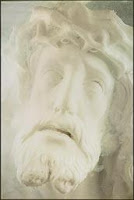If I didn’t know better I could be persuaded that aestheticians were mutating into philistines. For example Roger Kimball exclaims:
“The idea that art should serve as a source—perhaps the primary source—of spiritual sustenance in a secular age is a Romantic notion that continues to resonate powerfully. It helps to explain, for example, the special aura that attaches to art and artists, permitting such poseurs as Andres Serrano, Bruce Nauman, and Gilbert & George to be accounted artists by otherwise sane persons”[i]
It’s official. There is a special aura that attaches to art and artists and Serrano, Nauman and Gilbert and George have usurped this aura. I never realized that artists were so powerful. Next we’ll discover that artists can cure warts. Most of the artists who made the world’s great art are now deceased. I wonder if is documented anywhere that persons were able to see their aura. Are Rembrandt, Goya or Monet able to capture their own aura?
Such myths are the stock in trade of philistines; those who are indifferent to the artistic achievements of artists. Kimball, of course, seems to consider himself an aesthetician for he is adamant that beauty holds a supreme place in art.
“This much, I think, is clear: Without an allegiance to beauty, art degenerates into a caricature of itself; it is beauty that animates aesthetic experience, making it so seductive; but aesthetic experience itself degenerates into a kind of fetish or idol if it is held up as an end in itself, untested by the rest of life.” [i]
I’m inclined to want to test the argument that artists are beauty makers. Has Rembrandt created a caricature with his Slaughtered Ox or is Caravaggio’s Judith beheading Holferines a caricature. I find I can call these works
 artistically pleasing though not particularly attractive which seems to me to be the sine qua non of beauty. But contrary to Kimball I find Serrano’s Piss Christ and his White
artistically pleasing though not particularly attractive which seems to me to be the sine qua non of beauty. But contrary to Kimball I find Serrano’s Piss Christ and his WhiteChrist attractive as well as artistically pleasing. It is clear that Kimball uses the term ‘art’ honorifically.
“ Calling something a work of art endows it with a nimbus of value; the same is true of religious.”
We can take it from Kimball that beauty is the nimbus of value that allows us to call a work art. Consequently any work he deems not beautiful is simply not art. There is no such a thing as bad art in Kimball’s world. There is art and there are works that are affectations passing themselves off as art; poseurs. Kimball exposes the Achilles heel of aesthetics. The discipline of aesthetics offers no means of depreciating art works. A work is either art or not art. A work has either attained perfection or it is a different species incompatible with art. In Kimball’s world there is no such a thing as an ugly work of art. Jean Dubuffet’s Art Brut cannot be art.
But of course cave art is acclaimed by all to be art and nary a complaint about cave artists being poseurs is heard. The problem with Kimball’s argument is that he doesn’t depreciate the works he loathes as artistic events; he doesn’t discuss how they fail as artistic works. Rather he bemoans the fact that he cannot exercise his aesthetic impulse with them. But his actual chosen enemy is those critics who indulge “in a process of spurious aggrandizement” of what he believes to be “mediocre works”.[i] But Kimball doesn’t understand that his approach to art is inartistic. He criticizes his opponents as interlopers.
“More precisely, they poach upon the authority of art in order to pursue an entirely non-artistic agenda. Their interest in art is ulterior, not aesthetic.”[ii]
As Kimball only has an aesthetic interest he, too, poaches upon the authority of art to promote a non-artistic agenda. Artistic concerns are only relevant as he happens to recognize their effect on his aesthetic concerns. The integrity of a work based on the materials the artist uses, the techniques and methods applied, the style of the work and how it suits its subject matter is not a concern for this aesthetician. He doesn’t want to think about art, he wants to feel it. But, of course, the only thing he can feel is the echo of his maudlin response to an art work.
Launt Thompson
http://www.amazon.com/s/ref=nb_sb_noss?field-keywords=Launt+Thompson&url=search-alias%3Daps&x=16&y=9
[i] Kimball, Roger, The End of Art , in First Things The Journal of Religion, Culture and Public life, June/July 2008 http://www.firstthings.com/article.php3?id_article=6228





No comments:
Post a Comment